Unit 4 Body language 单元过关复习课件(共31张PPT)-2025-2026学年人教版(2019)选择性必修第一册
文档属性
| 名称 | Unit 4 Body language 单元过关复习课件(共31张PPT)-2025-2026学年人教版(2019)选择性必修第一册 | 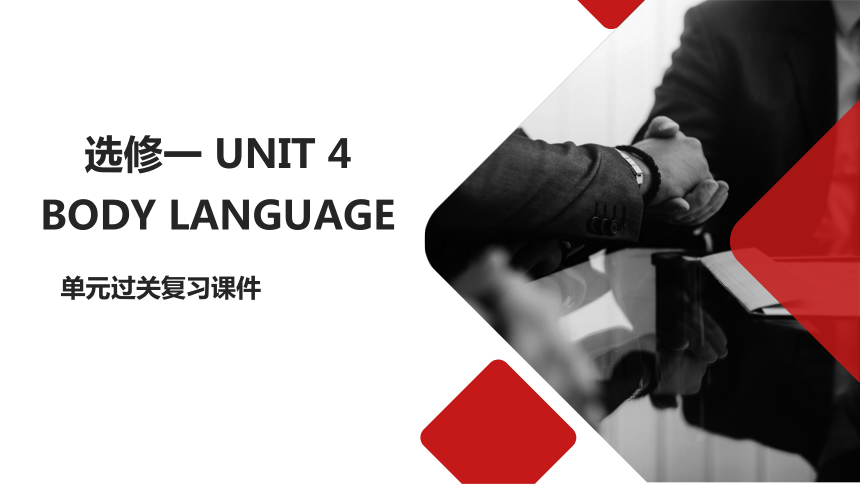 | |
| 格式 | pptx | ||
| 文件大小 | 4.7MB | ||
| 资源类型 | 教案 | ||
| 版本资源 | 人教版(2019) | ||
| 科目 | 英语 | ||
| 更新时间 | 2025-06-12 09:49:14 | ||
图片预览

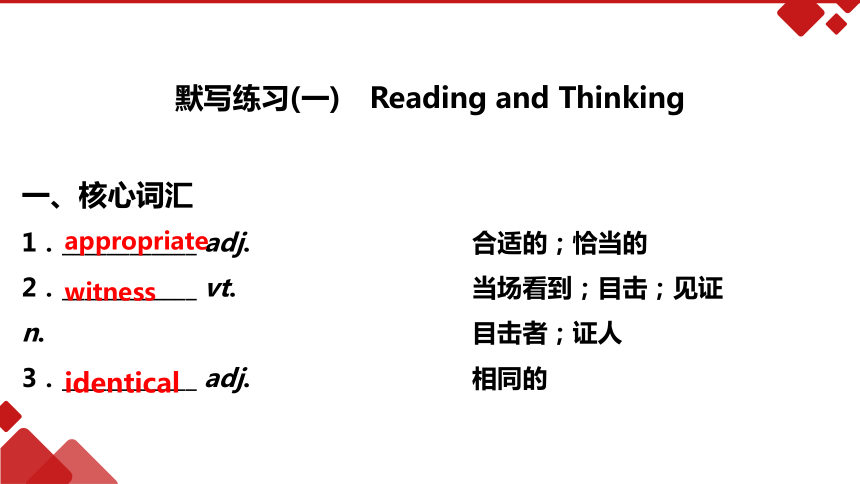

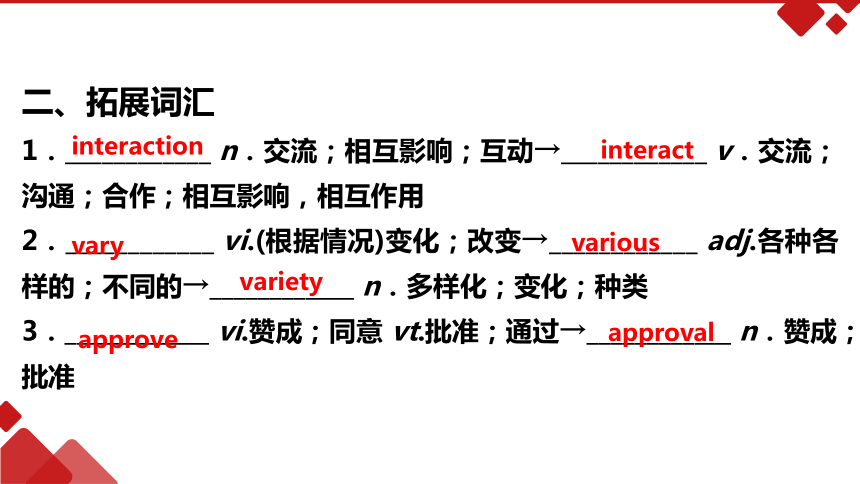
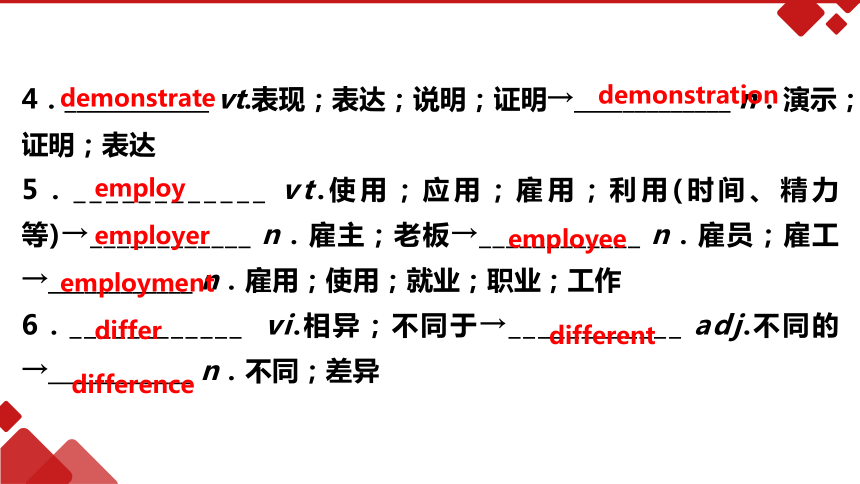

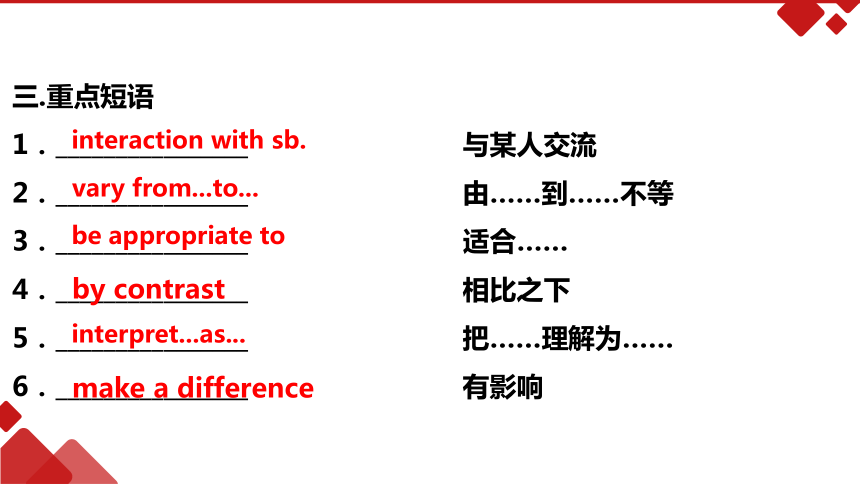
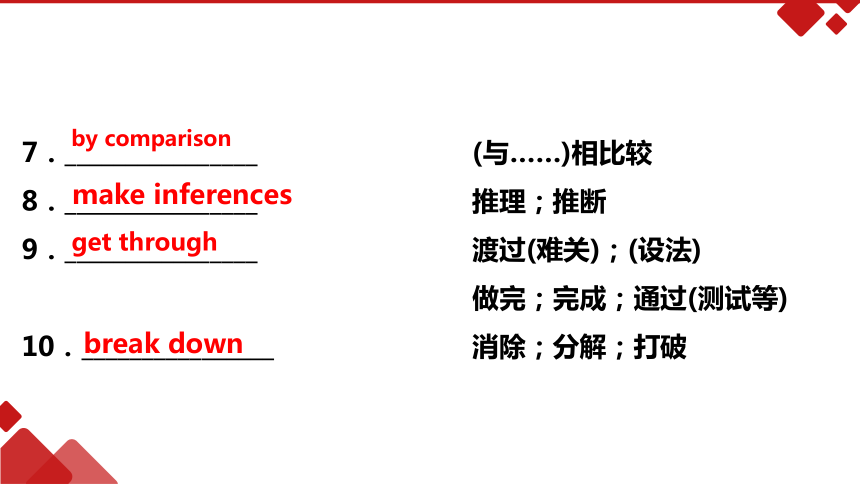
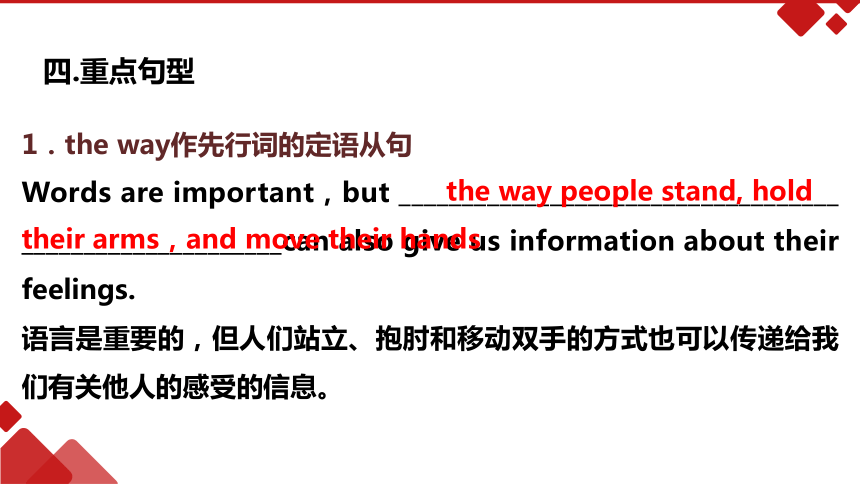
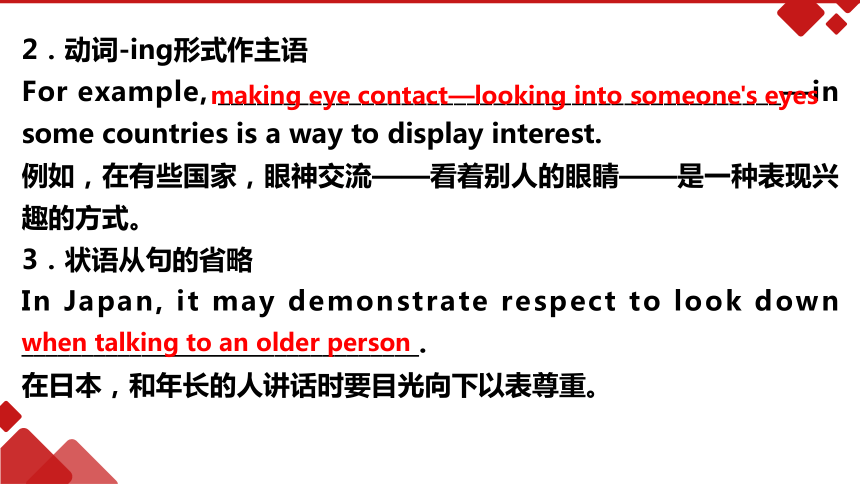


文档简介
(共31张PPT)
选修一 UNIT 4
BODY LANGUAGE
单元过关复习课件
默写练习(一) Reading and Thinking
一、核心词汇
1.____________ adj. 合适的;恰当的
2.____________ vt. 当场看到;目击;见证
n. 目击者;证人
3.____________ adj. 相同的
appropriate
witness
identical
4.____________ n. 面颊;脸颊
5.____________ vt. 较喜欢;选择;有利于
n. 帮助;恩惠;赞同
6.____________ vi. 鞠躬;点头
vt. 低(头)
n. 弓;蝴蝶结
7.____________ n. 腰;腰部
8.____________ n. 隔阂;障碍
favour
bow
waist
barrier
cheek
二、拓展词汇
1.____________ n.交流;相互影响;互动→____________ v.交流;沟通;合作;相互影响,相互作用
2.____________ vi.(根据情况)变化;改变→____________ adj.各种各样的;不同的→____________ n.多样化;变化;种类
3.____________ vi.赞成;同意 vt.批准;通过→____________ n.赞成;批准
interaction
interact
vary
various
variety
approve
approval
4.____________ vt.表现;表达;说明;证明→_____________ n.演示;证明;表达
5.____________ vt.使用;应用;雇用;利用(时间、精力等)→____________ n.雇主;老板→____________ n.雇员;雇工→____________ n.雇用;使用;就业;职业;工作
6.____________ vi.相异;不同于→____________ adj.不同的→____________ n.不同;差异
demonstrate
demonstration
employ
employer
employee
employment
differ
different
difference
7.____________ n.愤怒;怒气 vt.使生气;激怒→____________ adj.生气的
8.____________ adj.可靠的;可信赖的→____________ vi.依赖;依靠
anger
angry
reliable
rely
三.重点短语
1.________________ 与某人交流
2.________________ 由……到……不等
3.________________ 适合……
4.________________ 相比之下
5.________________ 把……理解为……
6.________________ 有影响
interaction with sb.
vary from...to...
be appropriate to
by contrast
interpret...as...
make a difference
7.________________ (与……)相比较
8.________________ 推理;推断
9.________________ 渡过(难关);(设法)
做完;完成;通过(测试等)
10.________________ 消除;分解;打破
by comparison
make inferences
get through
break down
1.the way作先行词的定语从句
Words are important,but ___________________________________ _____________________can also give us information about their feelings.
语言是重要的,但人们站立、抱肘和移动双手的方式也可以传递给我们有关他人的感受的信息。
the way people stand, hold their arms,and move their hands
四.重点句型
2.动词-ing形式作主语
For example, ___________________________________________—in some countries is a way to display interest.
例如,在有些国家,眼神交流——看着别人的眼睛——是一种表现兴趣的方式。
3.状语从句的省略
In Japan, it may demonstrate respect to look down _________________________________.
在日本,和年长的人讲话时要目光向下以表尊重。
making eye contact—looking into someone's eyes
when talking to an older person
4.不定式(短语)作目的状语
We can use a smile ____________________________________________ _________________________.
我们可以用微笑来道歉、问候某人、寻求帮助或者开始一段对话。
to apologise, to greet someone, to ask for help, or to start a conversation
5.“make+宾语+宾语补足语”结构
Experts suggest smiling at yourself in the mirror to _______________________________________________.
专家建议对着镜子里的自己微笑来让自己感到更快乐、更坚强。
make yourself feel happier and stronger
6.“否定词+比较级”表示最高级含义
And if we are feeling down or lonely,_________________________________________________________
_____________________.
并且如果我们感到沮丧或孤独,没有什么比看到好朋友的笑脸更好的了。
there is nothing better than seeing the smiling face of a good friend
默写练习(二) Learning About Language & Using Language
一、核心词汇
1.____________ n. 发生的事情;严重
事件;冲突
2.____________ n.& v. 审讯;审判;试验;试用
3.____________ adj. 双胞胎之一的;孪生之一的
n. 孪生之一;双胞胎之一
incident
trial
twin
4.____________ adj. 内部的;里面的
5.____________ n. 故作姿态;(为画像、
拍照等摆的)姿势
vi. 摆好姿势
vt. 造成(威胁、问题等)
6.____________ vt.& vi. (使)弯曲;倾斜;偏向
7.____________ vt. 揭示;显示;露出
internal
pose
bend
reveal
8.____________ vt. 使更清晰易懂;阐明;澄清
9.____________ vt. 把……放低;降低;减少
adj. 下面的;下方的;较小的
10.____________ adv. 几乎不;勉强才能;刚刚
11.____________ vi. 盯着看; 凝视
n. 凝视
12.____________ n. 天花板;上限
clarify
lower
barely
stare
ceiling
13.____________ n. 胸部;胸膛
14.____________ adv. 只是;仅仅;只不过
15.____________ vi.& vt. 费心;麻烦;因……操心
n. 麻烦;不便
16.____________ vi.& vt. 哭泣;流泪
17.____________ n. 矛盾;冲突
vi. 冲突;抵触
chest
merely
bother
weep
conflict
18.____________ n. 组成部分;零件
19.____________ n. 语气;腔调;口吻
component
tone
二、拓展词汇
1.____________ adj.轻微的;略微的;细小的→____________ adv.略微;稍微
2.____________ vt.评估;评价→____________ n.评价;评定
3.____________ n.教师;教育工作者;教育家→____________ vt.教育;教导;训练→____________ adj.受过教育的;有教养的→____________ n.教育;教育学;训练;培养
slight
slightly
assess
assessment
educator
educate
educated
education
4.____________ n.趋势;倾向→____________ v.往往会;倾向于,趋向
5.____________ vt.占领;占据;占用 →____________ n.占领;职业;工作→____________ adj.忙于……的,使用中的,被占领的
6.____________ vt.分散(注意力);使分心→____________ n.注意力分散;分心→____________ adj.分心的;注意力分散的
tendency
tend
occupy
occupation
occupied
distract
distraction
distracted
7.____________ vi.& vt.区分;辨别→____________ adj.卓越的;杰出的;著名的
8.____________ n.焦虑;担心;害怕→__________ adj.焦急的,焦虑的
9.____________ adj.难堪的;尴尬的→____________ vt.使尴尬→____________ adj.令人尴尬的→______________ n.窘迫;难堪;困境
distinguish
distinguished
anxiety
anxious
embarrassed
embarrass
embarrassing
embarrassment
10.____________ adj.羞愧;惭愧→____________ n.羞耻,羞愧;惭愧→____________ adj.可耻的;不道德的→____________ adj.无耻的
11.____________vi.& vt.询问;打听→____________ n.询问;打听
12.____________ vt.调整;调节 vi.& vt.适应;(使)习惯→____________ n.调整;调节;适应
13.____________ vi.(对……)起反应;回应;(对食物等)有不良反应→____________ n.反应;回应
ashamed
shame
shameful
shameless
inquire
inquiry
adjust
adjustment
react
reaction
三.重点短语
1.________________ 直起来;整理;收拾整齐
2.________________ 换句话说;也就是说
3.________________ 向前倾斜
4.________________ 倾向于;往往
5.________________ 向上看;查阅
6.________________ 盯着……看
straighten up
in other words
lean forward
have a tendency to
look up
stare at...
7.________________ (短暂地)访问;要求(某
人讲话等);正式邀请
8.________________ 费心地做某事
9.________________ 在工作
10.____________________ 与某人有冲突
11.________________ 适应于……
12.________________ 对……做出反应
13.________________ 坐下休息
call on
bother to do sth.
at work
have conflicts with sb.
adjust to
react to...
put one's feet up
四.重点句型
1.how引导宾语从句
As an educator, people often ask me ____________________________ _______________________________.
作为一名教师,人们经常问我,我怎么知道自己的学生在想什么。
how I know what is going on in the minds of my students
2.it作形式主语
At the same time, in a classroom of more than forty students, __________________________________________________________.
同时,在一个有40多名学生的教室里,很难与每个人进行多次一对一的谈话。
it is hard to have many one on one conversations with each person
3.when引导时间状语从句
______________________________________, they look confused.
当我谈论到难点时,他们看起来很困惑。
4.部分否定
Of course,_______________________________________________.
当然,不是每个抬头看的人都在专心听讲。
When I talk about something difficult
not everyone who looks up is paying attention in class
5.with复合结构
_______________________________,they occupy themselves by staring out of the window or up at the ceiling.
他们两手托着下巴,忙着盯着窗外或天花板。
With their chins on their hands
6.while引导让步状语从句
________________________ when students are interested, bored, or distracted, it is sometimes much harder to distinguish when students are troubled.
尽管很容易察觉学生们是何时感兴趣、何时感到无聊或何时精神不集中的,但要分辨出学生们何时有困扰有时会难得多。
While it is easy to perceive
7.“have+宾语+宾语补足语”结构
Students who are angry, afraid, or experiencing anxiety may _________________________________________________________
__________________, like they are guarding their bodies.
愤怒、害怕或者焦虑的学生可能会交叉他们的双臂抱在胸前,并拢或交叉他们的双腿,就像在保护自己的身体一样。
have their arms crossed in front of their chests and their legs closed or crossed
Thank you!
选修一 UNIT 4
BODY LANGUAGE
单元过关复习课件
默写练习(一) Reading and Thinking
一、核心词汇
1.____________ adj. 合适的;恰当的
2.____________ vt. 当场看到;目击;见证
n. 目击者;证人
3.____________ adj. 相同的
appropriate
witness
identical
4.____________ n. 面颊;脸颊
5.____________ vt. 较喜欢;选择;有利于
n. 帮助;恩惠;赞同
6.____________ vi. 鞠躬;点头
vt. 低(头)
n. 弓;蝴蝶结
7.____________ n. 腰;腰部
8.____________ n. 隔阂;障碍
favour
bow
waist
barrier
cheek
二、拓展词汇
1.____________ n.交流;相互影响;互动→____________ v.交流;沟通;合作;相互影响,相互作用
2.____________ vi.(根据情况)变化;改变→____________ adj.各种各样的;不同的→____________ n.多样化;变化;种类
3.____________ vi.赞成;同意 vt.批准;通过→____________ n.赞成;批准
interaction
interact
vary
various
variety
approve
approval
4.____________ vt.表现;表达;说明;证明→_____________ n.演示;证明;表达
5.____________ vt.使用;应用;雇用;利用(时间、精力等)→____________ n.雇主;老板→____________ n.雇员;雇工→____________ n.雇用;使用;就业;职业;工作
6.____________ vi.相异;不同于→____________ adj.不同的→____________ n.不同;差异
demonstrate
demonstration
employ
employer
employee
employment
differ
different
difference
7.____________ n.愤怒;怒气 vt.使生气;激怒→____________ adj.生气的
8.____________ adj.可靠的;可信赖的→____________ vi.依赖;依靠
anger
angry
reliable
rely
三.重点短语
1.________________ 与某人交流
2.________________ 由……到……不等
3.________________ 适合……
4.________________ 相比之下
5.________________ 把……理解为……
6.________________ 有影响
interaction with sb.
vary from...to...
be appropriate to
by contrast
interpret...as...
make a difference
7.________________ (与……)相比较
8.________________ 推理;推断
9.________________ 渡过(难关);(设法)
做完;完成;通过(测试等)
10.________________ 消除;分解;打破
by comparison
make inferences
get through
break down
1.the way作先行词的定语从句
Words are important,but ___________________________________ _____________________can also give us information about their feelings.
语言是重要的,但人们站立、抱肘和移动双手的方式也可以传递给我们有关他人的感受的信息。
the way people stand, hold their arms,and move their hands
四.重点句型
2.动词-ing形式作主语
For example, ___________________________________________—in some countries is a way to display interest.
例如,在有些国家,眼神交流——看着别人的眼睛——是一种表现兴趣的方式。
3.状语从句的省略
In Japan, it may demonstrate respect to look down _________________________________.
在日本,和年长的人讲话时要目光向下以表尊重。
making eye contact—looking into someone's eyes
when talking to an older person
4.不定式(短语)作目的状语
We can use a smile ____________________________________________ _________________________.
我们可以用微笑来道歉、问候某人、寻求帮助或者开始一段对话。
to apologise, to greet someone, to ask for help, or to start a conversation
5.“make+宾语+宾语补足语”结构
Experts suggest smiling at yourself in the mirror to _______________________________________________.
专家建议对着镜子里的自己微笑来让自己感到更快乐、更坚强。
make yourself feel happier and stronger
6.“否定词+比较级”表示最高级含义
And if we are feeling down or lonely,_________________________________________________________
_____________________.
并且如果我们感到沮丧或孤独,没有什么比看到好朋友的笑脸更好的了。
there is nothing better than seeing the smiling face of a good friend
默写练习(二) Learning About Language & Using Language
一、核心词汇
1.____________ n. 发生的事情;严重
事件;冲突
2.____________ n.& v. 审讯;审判;试验;试用
3.____________ adj. 双胞胎之一的;孪生之一的
n. 孪生之一;双胞胎之一
incident
trial
twin
4.____________ adj. 内部的;里面的
5.____________ n. 故作姿态;(为画像、
拍照等摆的)姿势
vi. 摆好姿势
vt. 造成(威胁、问题等)
6.____________ vt.& vi. (使)弯曲;倾斜;偏向
7.____________ vt. 揭示;显示;露出
internal
pose
bend
reveal
8.____________ vt. 使更清晰易懂;阐明;澄清
9.____________ vt. 把……放低;降低;减少
adj. 下面的;下方的;较小的
10.____________ adv. 几乎不;勉强才能;刚刚
11.____________ vi. 盯着看; 凝视
n. 凝视
12.____________ n. 天花板;上限
clarify
lower
barely
stare
ceiling
13.____________ n. 胸部;胸膛
14.____________ adv. 只是;仅仅;只不过
15.____________ vi.& vt. 费心;麻烦;因……操心
n. 麻烦;不便
16.____________ vi.& vt. 哭泣;流泪
17.____________ n. 矛盾;冲突
vi. 冲突;抵触
chest
merely
bother
weep
conflict
18.____________ n. 组成部分;零件
19.____________ n. 语气;腔调;口吻
component
tone
二、拓展词汇
1.____________ adj.轻微的;略微的;细小的→____________ adv.略微;稍微
2.____________ vt.评估;评价→____________ n.评价;评定
3.____________ n.教师;教育工作者;教育家→____________ vt.教育;教导;训练→____________ adj.受过教育的;有教养的→____________ n.教育;教育学;训练;培养
slight
slightly
assess
assessment
educator
educate
educated
education
4.____________ n.趋势;倾向→____________ v.往往会;倾向于,趋向
5.____________ vt.占领;占据;占用 →____________ n.占领;职业;工作→____________ adj.忙于……的,使用中的,被占领的
6.____________ vt.分散(注意力);使分心→____________ n.注意力分散;分心→____________ adj.分心的;注意力分散的
tendency
tend
occupy
occupation
occupied
distract
distraction
distracted
7.____________ vi.& vt.区分;辨别→____________ adj.卓越的;杰出的;著名的
8.____________ n.焦虑;担心;害怕→__________ adj.焦急的,焦虑的
9.____________ adj.难堪的;尴尬的→____________ vt.使尴尬→____________ adj.令人尴尬的→______________ n.窘迫;难堪;困境
distinguish
distinguished
anxiety
anxious
embarrassed
embarrass
embarrassing
embarrassment
10.____________ adj.羞愧;惭愧→____________ n.羞耻,羞愧;惭愧→____________ adj.可耻的;不道德的→____________ adj.无耻的
11.____________vi.& vt.询问;打听→____________ n.询问;打听
12.____________ vt.调整;调节 vi.& vt.适应;(使)习惯→____________ n.调整;调节;适应
13.____________ vi.(对……)起反应;回应;(对食物等)有不良反应→____________ n.反应;回应
ashamed
shame
shameful
shameless
inquire
inquiry
adjust
adjustment
react
reaction
三.重点短语
1.________________ 直起来;整理;收拾整齐
2.________________ 换句话说;也就是说
3.________________ 向前倾斜
4.________________ 倾向于;往往
5.________________ 向上看;查阅
6.________________ 盯着……看
straighten up
in other words
lean forward
have a tendency to
look up
stare at...
7.________________ (短暂地)访问;要求(某
人讲话等);正式邀请
8.________________ 费心地做某事
9.________________ 在工作
10.____________________ 与某人有冲突
11.________________ 适应于……
12.________________ 对……做出反应
13.________________ 坐下休息
call on
bother to do sth.
at work
have conflicts with sb.
adjust to
react to...
put one's feet up
四.重点句型
1.how引导宾语从句
As an educator, people often ask me ____________________________ _______________________________.
作为一名教师,人们经常问我,我怎么知道自己的学生在想什么。
how I know what is going on in the minds of my students
2.it作形式主语
At the same time, in a classroom of more than forty students, __________________________________________________________.
同时,在一个有40多名学生的教室里,很难与每个人进行多次一对一的谈话。
it is hard to have many one on one conversations with each person
3.when引导时间状语从句
______________________________________, they look confused.
当我谈论到难点时,他们看起来很困惑。
4.部分否定
Of course,_______________________________________________.
当然,不是每个抬头看的人都在专心听讲。
When I talk about something difficult
not everyone who looks up is paying attention in class
5.with复合结构
_______________________________,they occupy themselves by staring out of the window or up at the ceiling.
他们两手托着下巴,忙着盯着窗外或天花板。
With their chins on their hands
6.while引导让步状语从句
________________________ when students are interested, bored, or distracted, it is sometimes much harder to distinguish when students are troubled.
尽管很容易察觉学生们是何时感兴趣、何时感到无聊或何时精神不集中的,但要分辨出学生们何时有困扰有时会难得多。
While it is easy to perceive
7.“have+宾语+宾语补足语”结构
Students who are angry, afraid, or experiencing anxiety may _________________________________________________________
__________________, like they are guarding their bodies.
愤怒、害怕或者焦虑的学生可能会交叉他们的双臂抱在胸前,并拢或交叉他们的双腿,就像在保护自己的身体一样。
have their arms crossed in front of their chests and their legs closed or crossed
Thank you!
